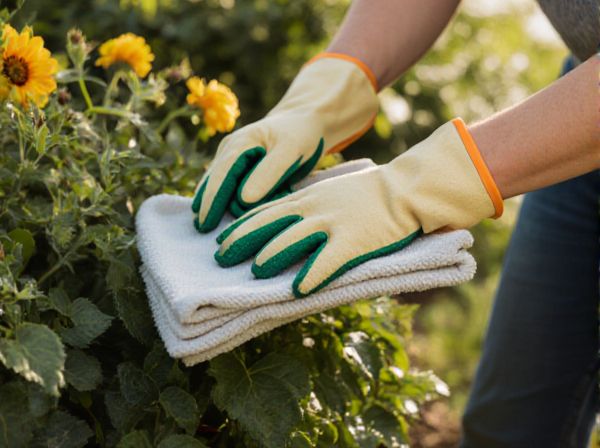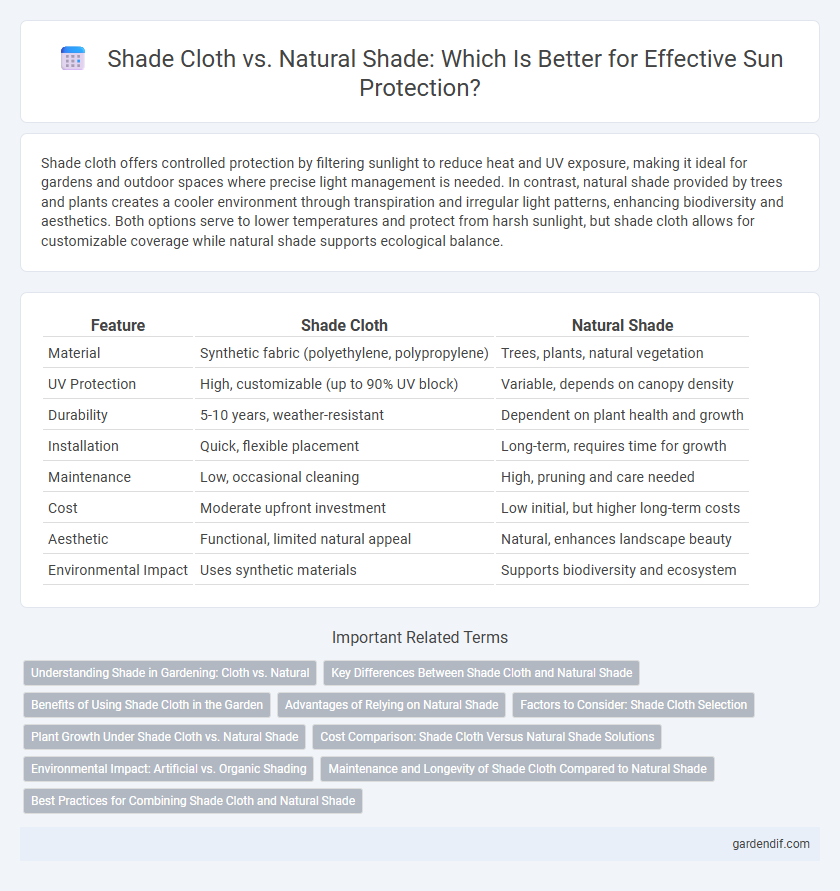
Shade Cloth vs Natural Shade Illustration
Shade cloth offers controlled protection by filtering sunlight to reduce heat and UV exposure, making it ideal for gardens and outdoor spaces where precise light management is needed. In contrast, natural shade provided by trees and plants creates a cooler environment through transpiration and irregular light patterns, enhancing biodiversity and aesthetics. Both options serve to lower temperatures and protect from harsh sunlight, but shade cloth allows for customizable coverage while natural shade supports ecological balance.
Table of Comparison
| Feature | Shade Cloth | Natural Shade |
|---|---|---|
| Material | Synthetic fabric (polyethylene, polypropylene) | Trees, plants, natural vegetation |
| UV Protection | High, customizable (up to 90% UV block) | Variable, depends on canopy density |
| Durability | 5-10 years, weather-resistant | Dependent on plant health and growth |
| Installation | Quick, flexible placement | Long-term, requires time for growth |
| Maintenance | Low, occasional cleaning | High, pruning and care needed |
| Cost | Moderate upfront investment | Low initial, but higher long-term costs |
| Aesthetic | Functional, limited natural appeal | Natural, enhances landscape beauty |
| Environmental Impact | Uses synthetic materials | Supports biodiversity and ecosystem |
Understanding Shade in Gardening: Cloth vs. Natural
Shade cloth provides consistent, controlled protection from intense sunlight by filtering specific percentages of UV rays, making it ideal for delicate plants and precise temperature regulation. Natural shade, created by trees or structures, offers a dynamic environment with variable light patterns and additional benefits like improved soil moisture retention and habitat for beneficial insects. Gardeners should consider plant species, sunlight tolerance, and microclimate needs when choosing between shade cloth and natural shade to optimize growth and yield.
Key Differences Between Shade Cloth and Natural Shade
Shade cloth provides controlled, adjustable light filtration using woven or knitted synthetic fibers, allowing precise management of sunlight exposure for plants and outdoor spaces. Natural shade, created by trees or structures, offers dynamic, uneven light patterns influenced by seasonal changes and environmental factors. Unlike natural shade, shade cloth can be tailored to specific shading percentages and UV protection levels, ensuring consistent and predictable shade conditions.
Benefits of Using Shade Cloth in the Garden
Shade cloth provides consistent and adjustable protection from intense sunlight, helping to regulate temperature and reduce water evaporation in garden plants. This controlled environment enhances plant growth and prevents damage caused by excessive UV exposure compared to natural shade, which can be uneven and less reliable. Using shade cloth also allows for targeted shading in specific areas, optimizing garden productivity and extending the growing season.
Advantages of Relying on Natural Shade
Natural shade offers energy-efficient cooling by reducing heat absorption without the need for artificial structures or materials, promoting environmental sustainability. It enhances air quality and biodiversity by supporting local flora and fauna, creating a healthier outdoor environment. Unlike shade cloth, natural shade adjusts dynamically with seasonal changes, providing optimal protection and comfort throughout the year.
Factors to Consider: Shade Cloth Selection
Shade cloth selection depends on fabric density, UV protection level, and durability to ensure optimal shading performance. Consider the specific plant or area requirements, including light filtration percentage and air circulation, to match the shade cloth type effectively. Material composition such as HDPE or woven polyethylene influences longevity and resistance to weather conditions, impacting long-term investment value.
Plant Growth Under Shade Cloth vs. Natural Shade
Shade cloth provides a controlled environment that filters sunlight, allowing optimal light transmission for photosynthesis and improving plant growth rates compared to natural shade. Natural shade can be irregular and inconsistent due to varying canopy density and seasonal changes, which may lead to uneven growth patterns. Using shade cloth enhances uniformity in light exposure, promoting healthier foliage, stronger stems, and higher yields in sensitive plants.
Cost Comparison: Shade Cloth Versus Natural Shade Solutions
Shade cloth offers a cost-effective solution with lower initial investment and maintenance expenses compared to natural shade options like trees, which require years to grow and ongoing care. While natural shade provides environmental benefits such as carbon sequestration and habitat support, the upfront and long-term financial outlay is significantly higher. Selecting shade cloth can lead to faster returns on investment, especially for agricultural or commercial applications seeking immediate and customizable shading.
Environmental Impact: Artificial vs. Organic Shading
Shade cloth reduces heat and UV exposure effectively but relies on synthetic materials that contribute to plastic waste and microplastic pollution. Natural shade from trees and plants promotes biodiversity, improves air quality, and supports carbon sequestration, making it environmentally sustainable. Choosing organic shading enhances ecosystem health and reduces the carbon footprint compared to artificial shade solutions.
Maintenance and Longevity of Shade Cloth Compared to Natural Shade
Shade cloth requires minimal maintenance, typically needing occasional cleaning to remove dust and debris, whereas natural shade such as trees demands regular care including pruning, watering, and pest control. The longevity of shade cloth ranges from 5 to 15 years depending on material quality and environmental conditions, while natural shade can last decades but varies significantly with tree health and species. Shade cloth provides a consistent and reliable shading solution with predictable durability, contrasting the variable lifespan and maintenance intensity of natural shade.
Best Practices for Combining Shade Cloth and Natural Shade
Combining shade cloth with natural shade optimizes light diffusion and temperature control for outdoor spaces and gardens. Use shade cloth with a UV-blocking rating of 50% to 70% over areas with moderate natural shade from trees like oaks or maples, enhancing protection without excessively limiting sunlight. Positioning shade cloth strategically to complement the existing tree canopy prevents overheating and promotes healthier plant growth by balancing direct and filtered sunlight.
Shade Cloth vs Natural Shade Infographic

 gardendif.com
gardendif.com